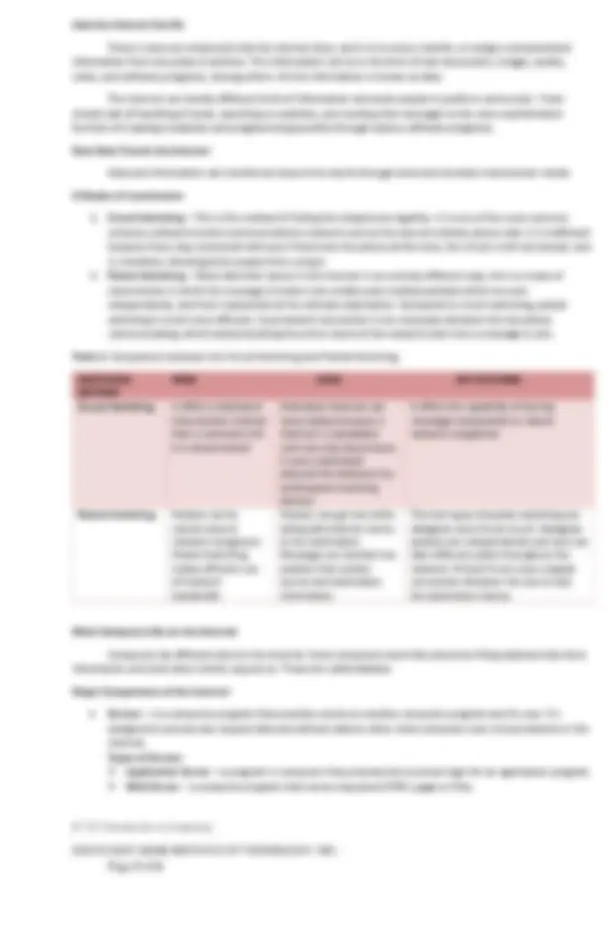





Study with the several resources on Docsity

Earn points by helping other students or get them with a premium plan


Prepare for your exams
Study with the several resources on Docsity

Earn points to download
Earn points by helping other students or get them with a premium plan
Community
Ask the community for help and clear up your study doubts
Discover the best universities in your country according to Docsity users
Free resources
Download our free guides on studying techniques, anxiety management strategies, and thesis advice from Docsity tutors
This learning module is for advance networking for second year college students.
Typology: Study notes
1 / 6

This page cannot be seen from the preview
Don't miss anything!




IT 121: Introduction to Computing
National Highway, Crossing Rubber, Tupi, South Cotabato
IT 121: Introduction to Computing
TITLE : Living in the IT Era
TARGET POPULATION : All BS Hospitality Management Students
INSTRUCTOR : Ms. Juliet Lugan
IT 121: Introduction to Computing
The Internet
Objectives:
Explore the current breakthrough technologies and disruptive innovations that have emerged over the past few years Discuss the evolution of media and analyzed the information presented. Identify different social media platforms and their improvements during the different generations.
Content: Digital Age Media in Digital Age Evolution of Media Overview of Current Trends
Internet The Internet or “net” (network of network) is the largest computer network in the world that connects billions of computer user via dedicated routers and servers. The word internet comes from combination between “interconnection” and “network”. Network is a collection of computers and devices connected via communication channels and transmission media allow to share resources (hardware, software, data, and information). Generally, nobody owns the internet. Large internet service providers own infrastructure through which is internet delivered.
Brief History of Internet January 2, 1969 – The Internet started from the Advanced Research Projects Agency’s Wide Area Network which is first called the ARPANET. This was established by the U.S Department of Defense so that the military’s research unit could collaborate with business and government laboratories.
In the Year 1982 – The word internet started. Other universities and U.S institutions were connected to ARPANET that resulted in the growth of the ARPANET different from everyone’s expectation.
In the Year 1986 – The First “free net” created in Case Western Reserve University.
In the Year 1991 - US government allowed business agencies to connect to internet. Now all people can connect to the internet and improve their life and work quality.
- The advancement of hypertext-based technology known World Wide Web (WWW) or just simply as the Web has provided the channels for displaying text, graphics, animations, etc.
In the Year 1996 – Internet2 is founded, it is a not-for-profit networking consortium founded by 34 university research institutions in the U.S. its provides a collaborative environment where U.S research in education organization work together and develop advanced technologies and innovative solutions such as telemedicine, research, community development and etc.
- Internet2 manages the Internet2 Network , a next- generation optical and internet protocol network that is capable in delivering enhanced network services and is better, faster, and more efficient than the typical internet or broadband connections. - As of May 2016, this community comprises 317 U.S. higher education institutions, 81 corporations, 64 affiliates, 43 regional and state education networks, and more than 65 national research and networking partners representing over 100 countries. - The Philippines, via Philippine Research, Education and Government Information Network (PREGINET), is among the international peers reachable via Trans-Eurasia Information Network (TEIN), one of the Internet2 peering relationship. - In August 2017, a national training course on nuclear neurology was held in which nationwide webcast among hospitals was made possible through the high-speed connectivity provided by PREGINET and the video conference server hosted locally at the Department of Science and Technology- Advance Science and Technology Institute (DOST-ASTI).
IT 121: Introduction to Computing
Jobs the Internet Can Do
There is only one simple job that the internet does, and it is to move, transfer, or assign a computerized information from one place to another. This information can be in the form of text documents, images, audios, video, and software programs, among others. All this information is known as data.
The internet can handle different kinds of information and assist people to perform various job – from simple task of handling of email, searching on websites, and sending chat messages to the more sophisticated function of creating a websites and programming possible through various software programs.
How Data Travels the Internet
Data and Information are transferred around the world through wired and wireless transmission media.
2 Modes of transmission
Table 1: Comparison between the Circuit Switching and Packet Switching.
SWITCHING METHOD
Circuit Switching It offers a dedicated transmission channel that is reserved until it is disconnected
Dedicated channels can cause delays because a channel is unavailable until one side disconnects. It uses a dedicated physical link between the sending and receiving devices.
It offers the capability of storing messages temporarily to reduce network congestion.
Packet Switching Packets can be routed around network congestion. Packet Switching makes efficient use of network bandwidth.
Packets can get lost while taking alternatives routes to the destination. Messages are divided into packets that contain source and destination information.
The two types of packet switching are datagram and virtual circuit. Datagram packets are independently sent and can take different paths throughout the network. Virtual Circuit uses a logical connection between the source and the destination device.
What Computers Do on the Internet
Computers do different jobs on the internet. Some computers work like electronic filing cabinets that store information and send when clients request so. These are called servers.
Major Components of the Internet
Servers – is a computer program that provides service to another computer program and its user. It’s designed to process any request data and delivers data to other client computer over a local network or the internet. Types of Servers Application Server – a program in computer that provides the business logic for an application program. Web Server – a computer program that serves requested HTML pages or files.